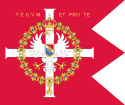
Back تاج مملكة بولندا Arabic Polşa Krallığı Taxt-tacı Azerbaijani Карона Каралеўства Польскага Byelorussian Карона Каралеўства Польскага BE-X-OLD Koruna polského království Czech Kongeriget Polens krone Danish Στέμμα του Βασιλείου της Πολωνίας Greek Krono de la Regno de Pollando Esperanto Corona del Reino de Polonia Spanish Couronne du royaume de Pologne French
Crown of the Kingdom of Poland | |||||||||||||
|---|---|---|---|---|---|---|---|---|---|---|---|---|---|
| 1385–1795 | |||||||||||||
| Anthem: "Bogurodzica" "Mother of God" "Gaude Mater Polonia"[1] "Rejoice, oh Mother Poland" | |||||||||||||
 The Crown of the Kingdom of Poland (red) within the Polish–Lithuanian Commonwealth in 1635. | |||||||||||||
| Status | Part of the Polish–Lithuanian Commonwealth (1569–1795) | ||||||||||||
| Capital | Kraków | ||||||||||||
| Official languages | Polish, Latin | ||||||||||||
| Religion | Roman Catholicism (state religion)[2] | ||||||||||||
| Demonym(s) |
| ||||||||||||
| Government | Unitary parliamentary Elective constitutional monarchy | ||||||||||||
| Legislature | Sejm | ||||||||||||
| Senate | |||||||||||||
| Chamber of Deputies | |||||||||||||
| Historical era | |||||||||||||
| August 14 1385 | |||||||||||||
| 1 July 1569 | |||||||||||||
| May 3, 1791 | |||||||||||||
| January 7 1795 | |||||||||||||
| Currency | |||||||||||||
| |||||||||||||
The Crown of the Kingdom of Poland (Polish: Korona Królestwa Polskiego; Latin: Corona Regni Poloniae) was a political and legal idea formed in the 14th century, assuming unity, indivisibility and continuity of the state. According to this concept, the state ceased to be the patrimonial property of the monarch or dynasty, but became a common good of the political community of the kingdom.[3] Such an idea allowed the state to function even in periods of interregnum and led to the formation of a system characteristic of Poland based on the parliamentarism of the nobility and the free election of the ruler.[4] At the same time, the idea of the crown went beyond existing political boundaries; lands lost in the past were considered to belong to it.[5]
The idea of the Crown in Central Europe first appeared in Bohemia and Hungary, from where the model was taken by kings Ladislaus the Short and Casimir III the Great to strengthen their power. During the reign of Louis the Great in Poland, who spent most of his time in Hungary, as well as during the interregnum following his death and the regency during the minority of his daughter Jadwiga, the idea was adopted by the lords of the kingdom to emphasize their own role as co-responsible for the state.[6]
- ^ "Gaude Mater Polonia Creation and History". Retrieved November 14, 2017.
- ^ Davies, Norman (2005). God's Playground A History of Poland: Volume 1: The Origins to 1795. Oxford University Press. p. 130. ISBN 9780199253395.
- ^ Frost 2015, p. 15.
- ^ Frost 2015, p. 14.
- ^ Frost 2015, p. 12.
- ^ Frost 2015, pp. 11–12.
© MMXXIII Rich X Search. We shall prevail. All rights reserved. Rich X Search

